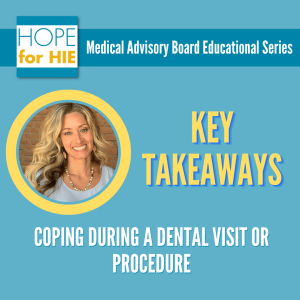
As a parent or caregiver of a medically complex child, you’re likely aware of the discomfort they may experience when visiting the dentist. From navigating inaccessible spaces to managing heightened sensitivities, every aspect of the dental visit can pose unique challenges. It may feel as if you’re constantly navigating these hurdles in order to provide them with the oral health care they need and deserve.
That’s why Annie Gunning, Hope for HIE’s certified child life specialist, recently engaged in a Q&A session aimed at equipping parents and dental providers with valuable tools, strategies, and resources to help your child cope during a dental procedure or visit and give them a much more inclusive and enjoyable experience.
Read on for access to Annie’s expertise and toolbox of resources!

In her role as the Child Life Specialist at Hope for HIE, Annie’s main objective is to help children and families navigate medicalized life. She focuses on empowering and supporting both children and their caregivers, fostering the ability to advocate for their needs while simultaneously reducing stress, pain, and anxiety. This often looks like support for patients and their families facing surgeries, tests, procedures, diagnoses, and hospitalizations by offering preparation, creating personalized coping plans, providing education, fostering creative expression, and incorporating medical play.
If you’re looking to seek the services of a Child Life Specialist in a hospital setting, check with the hospital’s healthcare team! You can reach out to their child life department, pediatric unit, or patient services to inquire about the availability and services provided by a Child Life Specialist, or you can see if your hospital has information on their website regarding the roles and contact details of their dedicated CCLS.

Communicating your child’s needs before the appointment can make a big difference, as it allows the dental team to better understand your child and tailor their approach accordingly. This communication doesn’t always have to look like sending over a detailed rundown of your child’s medical records; there are other options to consider when formulating your own approach:
➡️ Discuss sensory needs and experiences: Ask to talk with the dental staff beforehand about your child’s sensory sensitivities and what type of sensory experiences they may have. Do they have oral aversion? Is there a type of sound or feeling you anticipate being problematic? A provider who is willing to go over these nitty-gritty details is one who is most likely invested in modifying their toolkit to ensure your child has the most successful or stress-free visit possible.
➡️ Ask for a script or step-by-step process: Understanding the order of events that your child will experience will help you know how to best prepare them for the visit. Annie suggests using sequential sensory information — what they will touch, taste, hear, and smell in the order that they happen — to help familiarize your child with these sensations and to help them envision what the experience will look like. As the expert on your child, you can decide what information would be helpful for them to know in advance versus the pieces of information that would only cause them more worry or stress.
| A sample script can look like this:
⏺️ You’ll either sit on my lap or lay back in a reclining chair and open your mouth. ⏺️ Sometimes, it can be hard to keep your body still while the dentist looks in your mouth. Is there something you’d like to hold to help you during this? ⏺️ The dentist and hygienist(the dentist’s helper) will use different tools to check your teeth. You may feel pressure as they count and clean your teeth and gums. I can show you what this pressure feels like. ⏺️ They have a tool that squirts water — it can feel cold, but the pressure is soft and won’t hurt your teeth or gums. They have a straw to help suction the extra water so you don’t have to spit or swallow. ⏺️ They will use a toothbrush that makes a buzzing sound and spins around to clean your teeth and floss to clean in between your teeth. This can tickle your gums – do you want to see what that feels like now? |
➡️ Request a tour of the office: This allows you and your child to meet the staff prior to the dental visit, see the rooms, look at the bright lights, and, if they are willing, taste the toothpaste, feel the spinning toothbrush, etc. The hope is that introducing these experiences in a stress-free manner will make the actual experience less worrisome.
There are developmentally appropriate strategies to use that can help prepare your child for the dentist. Select some options from the toolkit below:
Younger Developmental Strategies:
➡️ Dental Play: Use dolls/stuffed animals, superheroes, toothbrushes, and flashlights. Take turns with who gets to be the dentist and the patient. Have them play with the tools, or encourage them to practice laying back in the chair or whatever comfort position they’ll sit in while you check their teeth. Play-Doh and Melissa and Doug brands both have dental sets to consider using.
➡️ Sing Songs: Singing songs that encourage repetitious actions, like opening your mouth on a certain line or word, can dually serve as a form of distraction that also encourages a more positive association with these and other similar actions that take place during an appointment.
➡️ Create a Coping Kit: Add items that encourage feelings of safety and calm. Offer choices of what they would like to hold, whether that’s a stuffed animal, stress ball, or sunglasses to take away from the bright lights. Maybe include an item that can act as a stress signal.
➡️ Read Books or Watch Videos: Reading stories or watching videos/episodes that portray the experience positively and emphasize the importance of dental care can be a powerful tool for prepping your child.
Older Developmental Strategies:
➡️ Advanced Discussions: Have an open conversation with your child about what will happen during their dental visit. Answer any questions they may have and address any concerns to alleviate anxiety, and be sure to address the education piece of WHY taking care of our teeth is important.
➡️ Visit the Office: Arrange a pre-appointment visit to the dental office, if possible. This allows your child to familiarize themselves with the environment, meet the staff, and ask questions in a non-threatening setting.
➡️ Create a Stress Reduction Plan: This can include listening to music or planning to eat their favorite meal before or after the appointment. Create a list of items or activities that both of you know will lessen their anxiety levels to perform or bring on that day.

Parents, the dental team, and other professionals like Child Life Specialists can collaborate to establish a familiar, comfortable, and positive environment for children at the dental office. Depending on your child’s unique circumstances, simple strategies will do the trick, while distracting from the fear or concern will work better for others. Annie has a list of versatile strategies that you can use as a foundation for building your coping toolkit:
STRATEGIES
DISTRACTIONS
We know that every child and every experience is different — if you’re interested in hearing other parents’ experiences and insights with dental visits and procedures, take a look at our Navigating Oral Motor and Dental Health Peer Perspective group, in which two HIE parents discuss what strategies worked best for their children.

As we all know, despite our efforts, dental visits do not always go as planned. Even in the event that your child shows signs of stress or resistance, there are still ways to manage the appointment and experience success.
➡️ Take a break: Your child may benefit from periodic breaks, which can prevent their stress levels from getting too high to a point where it may be hard to recover and resume.
➡️ Ask about their needs: Give them opportunities to state what they need in order to feel calm and comfortable, giving them a sense of ownership and control over their environment.
➡️ Address their fears: Simply asking what their fear is has the potential to help, especially because these fears can often be a misconception.
➡️ Offer viable choices: When an action is mandatory, don’t give them an out; instead, give them a viable choice. For example: We have to look into your mouth — would you rather look at Person A or Person B when you do it?
➡️ Set safety boundaries: Validate their emotion, but establish firm boundaries with actions they cannot do, like hitting. Offer an alternative, like squeezing a hand instead, or try and gamify the situation: Let’s pretend we are frozen and we can only blink our eyes! Who will stay frozen for longer — me or you?
➡️ Offer or request alternatives: If a technique is not working, ask the dental staff if there is another option or technique they can use instead. On a similar note, find new alternate focuses for distractions — change the movie, the music, play I-Spy, etc.
➡️ Engage their interests: Having an All About Me document to give to the staff is a wonderful and quick way for them to understand your child and engage them in the topics of discussion that most interest them. Consider putting categories, like Things that make me feel calm or Things that make me feel scared to make it so your child does not have the sole burden of informing the staff of their preferences.

Watch the full recording, along with our other Child Life Q&As, on Hope for HIE’s YouTube channel under the Child Life Series playlist, or download our Key Takeaway resource for an at-a-glance look at how to help your kids cope during a dental appointment or procedure!
Connect with families, read inspiring stories, and get helpful resources delivered right to your inbox.